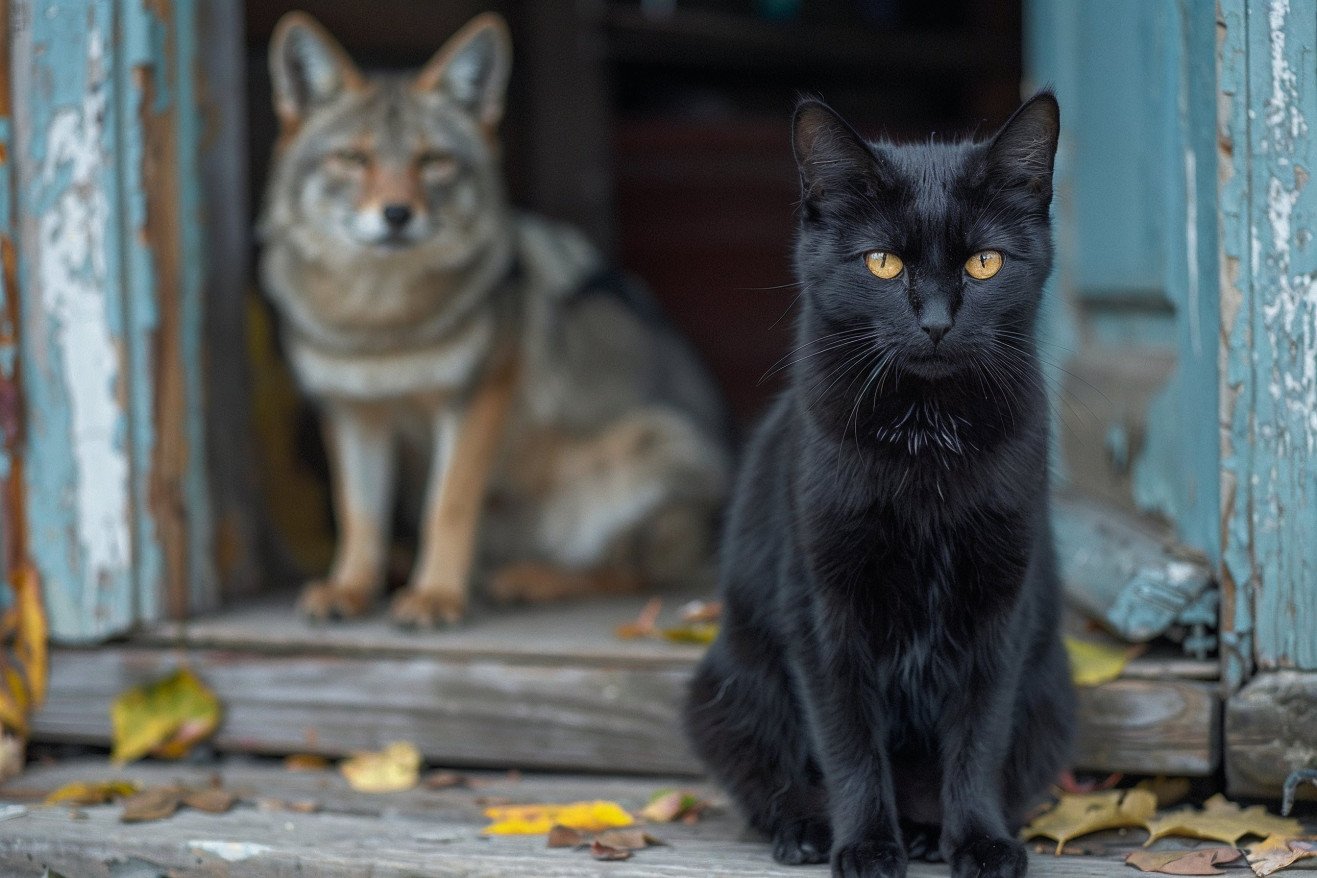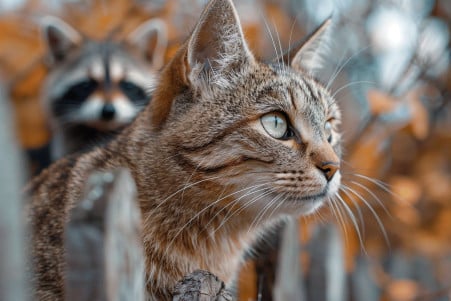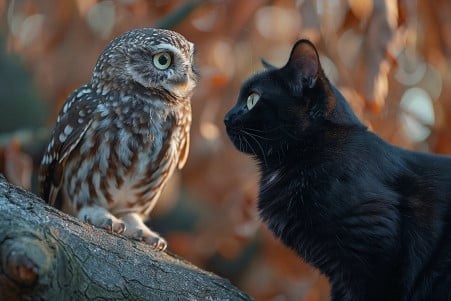Coyotes and Cats: How to Keep Your Cat Safe From Predation
25 April 2024 • Updated 25 April 2024

Coyotes are opportunistic predators that are known to prey on small pets like cats in urban and suburban areas, but there are ways to reduce the risk to your cat. Coyotes primarily eat rabbits, rodents, and other small mammals, but they have also been shown to kill cats, especially in areas near wildland-urban interfaces where coyotes have established dens and during the night. Keeping cats indoors, especially at night, using coyote-proof enclosures, and removing food attractants can help reduce the risk of coyote predation.
To learn more about this threat to our pet cats, we'll delve into the research of wildlife biologists, animal behaviorists, and urban ecologists. These researchers have studied the feeding patterns and hunting strategies of coyotes, particularly in suburban areas where coyotes live in close proximity to humans. By learning about the factors that make pet cats more vulnerable to coyote predation, we can work to reduce conflicts through targeted prevention.
Do coyotes eat cats?
How Often Do Coyotes Actually Eat Cats?
Coyotes are opportunistic omnivores that eat a wide variety of food including small mammals, fruits, insects, carrion, and even domestic pets. While this may be alarming to cat owners, research has shown that cats are only a small part of the urban coyote diet, making up between 1-2% of what coyotes eat, with rodents being the most common food source. That said, other studies have shown that coyotes in urban areas eat more human-related food, including pets, up to 35% of their diet.
This discrepancy in how often cats are eaten by coyotes is likely due to the methods used in the studies. Research that looked at coyote scat found that cats were eaten less frequently, while research that directly observed coyotes like that in Tucson found that cats made up 42% of their diet. In addition, the time of year can impact when coyotes hunt and what they eat, with deer making up a larger percentage of their diet in the winter when snow makes it harder for deer to move around. Knowing when coyotes are more likely to eat cats can help pet owners protect their animals.
Things That Impact Coyote Attacks on Cats
The likelihood of coyotes preying on domestic cats is higher when there is a lot of spatial overlap between the habitats of the two species. One study in Chicago showed that free-roaming cats and coyotes frequently used the same urban green spaces, leading to an increased risk of predation on cats. Coyotes are also more likely to prey on cats during the pup-rearing season from May to August when they need more food to feed their growing litters. Another study in Arizona found that 68% of coyote-cat interactions that resulted in a kill happened during this time.
In addition, some individual coyotes can develop specialized hunting techniques that make them more likely to catch cats. One study found that an alpha male coyote was responsible for 63% of the observed cat kills, indicating that he had learned how to effectively hunt this prey. In some areas, including the Southwest, coyotes are more likely to be bold and less likely to be afraid of humans, which can lead to more cats being hunted.
Finally, the large number of free-roaming and feral cats in urban areas provides an easy food source that can attract coyotes and lead to more conflicts. Studies have shown that domestic cats are a much larger part of the coyote diet in Southern California than in other parts of the country. These are all important things to know when it comes to preventing coyote predation on cats.
What Can You Do to Keep Your Cat Safe From Coyotes?
According to Catster, the best way to prevent coyote attacks on cats is to keep them indoors, especially at night when coyotes are most active. In addition, The Comforted Kitty suggests that installing tall fences (at least 6 feet) and providing elevated cat posts can help keep coyotes at bay.
In general, MedVet recommends removing potential food sources like pet food and unsecured trash to discourage coyotes from coming into yards. Meanwhile, Urban Coyote Research notes that coyote deterrents like motion-activated lights or sound devices can be effective in scaring coyotes away from small areas.
Finally, The Comforted Kitty points out that microchipping cats and avoiding declawing can help cats survive a coyote attack. By following these guidelines, cat owners can lower the risk of coyote attacks on their pets.
How Can Urban Coyote Populations Be Managed?
Traditional lethal control methods such as hunting and poisoning are not effective for managing urban coyote populations, according to Ohioline. As a result, non-lethal methods including hazing, deterrents, and population control through sterilization are becoming more popular, according to the Journal of Urban Ecology. In addition, public education, enforcing no-feeding ordinances, and incident reporting systems can help reduce conflicts, according to Ohioline.
Proactive hazing techniques are effective at deterring habituated coyotes, while reactive hazing is not, according to the Journal of Urban Ecology. While lethal removal may be necessary for coyotes that are an immediate threat, it should be a last resort, according to Project Coyote. It's important to understand the effectiveness and public perceptions of different management methods in order to develop comprehensive strategies that protect people while also conserving coyotes.
Living with Urban Coyotes: Protecting Pets While Preserving Urban Wildlife
Although coyote attacks on humans are extremely rare, with only one documented fatal attack in North America, their presence in urban areas can lead to concerns about pet safety, reports Discover Magazine. Yet, coyotes are also important for controlling rodent populations and maintaining ecological balance in urban environments.
Proper pet supervision, the removal of food attractants, and hazing can help prevent conflicts and enable people and their pets to safely coexist with coyotes, according to the Humane Society. This requires an understanding of coyote behavior and a recognition of their role in the urban ecosystem.
Meanwhile, long-term solutions call for the development of comprehensive management plans that take into account the needs of both people and coyotes, notes Discover Magazine. Through these efforts, we can protect our pets and promote coexistence while still benefiting from the ecological services coyotes offer in our shared environment.
Conclusion: How to Keep Pets Safe While Coexisting With Urban Wildlife
Coyotes are an important part of urban ecosystems, but they can also pose a threat to pets. To prevent predation on cats, it is important to understand coyote behavior, diet, and the factors that make cats more vulnerable to coyote attacks.
Preventative measures, including responsible pet ownership, environmental modifications, and deterrents, can be used to protect cats. Non-lethal management strategies that focus on coexistence are more likely to be successful and have greater public support. Finding a balance between protecting people and conserving coyotes will require the use of comprehensive, evidence-based management plans.


